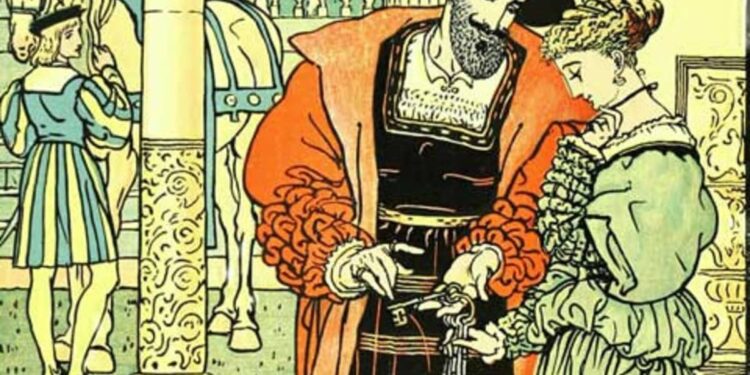Table of Contents
ToggleIntroduction
Bluebeard Summary And Themes By Charles Perrault Charles Perrault (1628–1703), a French author and member of the Académie Française, is best known for his fairy tales that have endured through generations. His stories, many of which are part of the literary tradition of fairy tales, have been retold in various forms across cultures and mediums. Perrault’s fairy tales include some of the most famous stories in the world, such as Cinderella, Sleeping Beauty, and Little Red Riding Hood. These stories not only entertain but also convey morals and lessons that are still relevant today.
One of Perrault’s lesser-known yet compelling fairy tales is Bluebeard, a dark and tragic story that explores themes of curiosity, trust, and the consequences of disobedience. First published in 1697, Bluebeard tells the tale of a wealthy and violent nobleman with a terrifying secret, and the young woman who must navigate his dangerous world. The story’s captivating narrative, filled with suspense and dread, serves as both a cautionary tale and a commentary on power dynamics, the consequences of violating trust, and the dangers of unchecked authority.
Summary of Bluebeard by Charles Perrault
The Story’s Plot:
Bluebeard begins with the introduction of a rich and handsome nobleman who has a reputation for being terrifying, largely because of his unusual appearance: his beard is blue, a color that makes him stand out and gives him an ominous air. Known as Bluebeard, the nobleman has been married several times, but all of his wives have mysteriously disappeared. The reason for their disappearance is unknown, and this fact has fueled much gossip and speculation in the surrounding community.
Despite his intimidating reputation, Bluebeard becomes interested in a young woman, the daughter of a wealthy merchant. He proposes marriage to her, and after much persuasion, she agrees to the marriage. However, before they are wed, Bluebeard gives his new bride the keys to all the rooms in his grand, isolated mansion, but he forbids her from entering one particular room—the one with a mysterious and locked door. He warns her that if she disobeys him, there will be dire consequences.
Read more
Bluebeard leaves on a business trip, and his wife is left alone in the mansion. Curiosity gets the better of her, and she decides to disobey her husband’s command. She enters the forbidden room and is horrified to discover the gruesome truth: the room is filled with the bodies of Bluebeard’s previous wives, all of whom have been murdered. She drops the key to the room in a pool of blood, and when she attempts to clean it, she finds that the key no longer works. The bloodstain cannot be removed, and the key becomes a symbol of her guilt and disobedience.
When Bluebeard returns and learns of his wife’s disobedience, he becomes enraged and threatens to kill her. However, her brothers, who have been suspicious of Bluebeard, arrive just in time to save her. They kill Bluebeard and free the young wife from his terror. The wife inherits all of Bluebeard’s wealth, and her brothers are rewarded for their bravery. She then marries another, kinder man, leaving behind the dark memory of her marriage to Bluebeard.
Key Characters
- Bluebeard: The story’s antagonist, Bluebeard is a wealthy and powerful nobleman with a mysterious and frightening reputation. He is cruel and manipulative, controlling his wife through fear and intimidation. His blue beard, which gives him his name, serves as a symbol of his monstrous nature. Bluebeard represents unchecked power and violence, with his dark secret being the ultimate manifestation of his cruelty.
- The Young Wife (The Heroine): The protagonist of the story, the young wife is initially portrayed as a naive and trusting woman who is seduced by Bluebeard’s wealth and status. However, as the story progresses, she becomes more curious and defiant. Her disobedience and curiosity lead to the discovery of Bluebeard’s horrific secret. Despite her fear, she manages to survive and, with the help of her brothers, escapes her marriage to Bluebeard.
- The Brothers: The young wife’s brothers are crucial to the resolution of the story. They are the ones who rescue her from Bluebeard’s clutches and bring about his death. Their bravery and loyalty stand in stark contrast to Bluebeard’s cruelty and violence.
- The Servants and Other Wives: Although they play less prominent roles in the narrative, the servants in Bluebeard’s household and the previous wives who are murdered also contribute to the story’s atmosphere of dread and horror. The wives, in particular, symbolize the victims of Bluebeard’s oppressive and violent nature.

Themes in Bluebeard by Charles Perrault
1. Curiosity and the Consequences of Disobedience
One of the most prominent themes in Bluebeard is the idea of curiosity, particularly the destructive consequences of disobedience. The young wife is warned by Bluebeard not to enter the forbidden room, and her eventual decision to do so leads to her discovery of his horrific secret. This theme is often interpreted as a moral lesson on the dangers of giving in to curiosity and the importance of respecting authority. However, it can also be read as a critique of oppressive control, where the wife’s desire for knowledge and autonomy is punished rather than encouraged.
While the young wife’s curiosity ultimately leads to her survival, it is also the source of the trauma she experiences. This duality suggests that curiosity, while natural and often necessary for growth, can have dangerous consequences in the face of absolute authority.
2. Power and Gender Roles
Another key theme in Bluebeard is the relationship between power and gender. Bluebeard, as the male authority figure, exercises absolute control over his wife, both through his wealth and his explicit command to keep out of the forbidden room. This power dynamic is central to the narrative, and it highlights the unequal distribution of power between men and women, particularly in the context of marriage.
Bluebeard’s treatment of his wives as disposable objects, whom he kills without remorse, reveals the darker side of patriarchal control. The young wife, initially powerless in her marriage, is only able to escape this violence with the intervention of her brothers, who represent male protection and authority.
3. Morality and Justice
The story of Bluebeard is also a commentary on morality and justice. While Bluebeard’s actions are cruel and unjust, the story presents a form of divine or karmic justice when Bluebeard is ultimately killed by the young wife’s brothers. This justice is not administered by the authorities or any formal legal system but rather through familial loyalty and revenge.
The ending of the story suggests that justice is served when Bluebeard is punished for his violent behavior, and the wife is liberated from his grasp. However, there is an implicit tension in the idea that the wife’s salvation comes through male intervention, raising questions about the role of women in asserting their own justice in the story.
Read more
4. The Corruption of Wealth and Status
Bluebeard’s wealth and status are depicted as symbols of his moral corruption. His immense power allows him to control his wife and other women in his life. Despite his outward appearance of nobility and respectability, his violent nature and dark secret reveal that his wealth is built on cruelty and manipulation. This theme speaks to the idea that wealth and status can mask deep moral failings, and that those who appear virtuous on the surface may be hiding terrible secrets.
5. Survival and Empowerment
While the story centers on the victimization of the young wife, it also conveys a theme of empowerment and survival. Despite her initial fear and vulnerability, the wife demonstrates courage and resourcefulness in the face of danger. Her survival is not solely attributed to her brothers but also to her own ability to navigate the treacherous situation she finds herself in. Her eventual freedom and the wealth she inherits signal her transition from victim to survivor, empowered to shape her own future.

Conclusion
Bluebeard by Charles Perrault is a gripping and thought-provoking fairy tale that delves into themes of curiosity, power, gender, and justice. Through the story of a young wife and her dangerous marriage to the violent Bluebeard, Perrault presents a tale of survival and the consequences of disobedience in the face of oppressive authority.
Though it is a product of its time, Bluebeard continues to resonate with readers today, offering insights into human nature, the complexities of power, and the importance of autonomy and moral responsibility.
Read more
FAQ
Q1: What is the moral of Bluebeard?
The moral of Bluebeard is often interpreted as a cautionary tale about the dangers of curiosity and disobedience, particularly for women in patriarchal societies. However, it can also be seen as a critique of unchecked power, especially male power, and the consequences of being subjugated to authority. The story underscores the importance of trust, autonomy, and the potential dangers of blind obedience.
Q2: Why does Bluebeard kill his wives?
Bluebeard’s motives for killing his wives are not explicitly stated in the story, but they are widely understood as arising from his need for control and his desire to maintain his authority over them. His actions suggest a pattern of violent behavior rooted in power, domination, and a lack of respect for the autonomy and lives of the women he marries.
Q3: What does the forbidden room symbolize?
The forbidden room in Bluebeard serves as a symbol of hidden knowledge, temptation, and the consequences of disobedience. It represents the unknown and the dangers that lie beyond it, but it also reflects the oppressive control Bluebeard exerts over his wife. The room is a metaphor for the dark secrets that exist in Bluebeard’s life, as well as the wife’s own desire to understand the truth.
Q4: How does the story reflect gender dynamics?
Bluebeard highlights the power imbalances between men and women, particularly within the context of marriage. Bluebeard’s control over his wife and the punishment she faces for disobeying him demonstrate the ways in which women are subjugated to male authority. At the same time, the wife’s eventual survival and the involvement of her brothers show that women’s empowerment is often depicted in relation to male action, which raises questions about gender roles and agency.
Q5: How does Bluebeard compare to other fairy tales?
Unlike many other fairy tales, which tend to have more whimsical or romantic tones, Bluebeard is darker and more violent. The story deals with themes of betrayal, power, and justice, which are more mature and morally complex. It also lacks the traditional “happily ever after” seen in many fairy tales, instead focusing on survival, empowerment, and the aftermath of violence.
Read more

















